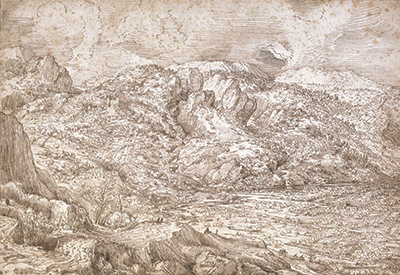Pieter Bruegel the Elder, known for his "peasant pictures", was also admired for his lovely landscapes.
The scope and grandeur of alpine landscapes in northern Italy inspired many of Bruegel's nature artworks (paintings, etchings, drawings), and this finely detailed "Alpine Landscape" is a gracious example of Bruegel's vision of nature.
Always on the look out for new and inspiring panoramas, Bruegel was encouraged to seek new inspiration in Italy, which he did in 1552-1553. The Italian countryside turned out to be the perfect setting; he was able to give full rein to his admiration and appreciation of nature, producing an interesting series of landscapes and nature studies.
In particular, the soaring Alps were a source of unparalleled inspiration for Bruegel in this period. He used some clever techniques to convey the enormity and the sheer mass of the majestic, imposing and overwhelming proportions of these gigantic, uprising rocks attempting to touch heaven.
One of these techniques is evident in this alpine picture: looking closely, we can see that the landscape is dotted with houses, roads, trees, people, as well as nature elements, trees and bushes, all finely detailed and all looking minuscule among the towering massiveness of the surrounding mountains.
The original "Alpine Landscape" by Pieter Bruegel the Elder dates from 1553 and currently hangs in the Louvre. It is an intriguing small drawing, 23cm x 34cm, done in pen and brown ink. The absence of colour renders it curious and compelling, and the imposing majesty of the mountains is forcefully portrayed just by Bruegel's fine brown lines. Prior to taking up residence in the Louvre, the picture was part of a private collection belonging to Pierre-Jean Mariette, an art dealer and collector.
In 1722, Mariette became art adviser to Pierre Crozat, a rich banker and art collector. He purchased part of the Crozat collection, which included two Pieter Bruegel landscapes of the same period (1553-1555). He was much taken with this one, with its fine details and its brown ink; he described it as "supremely beautiful".




